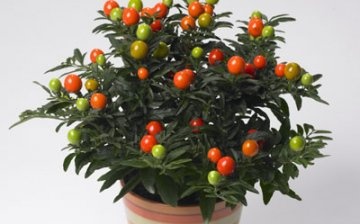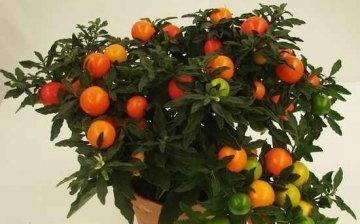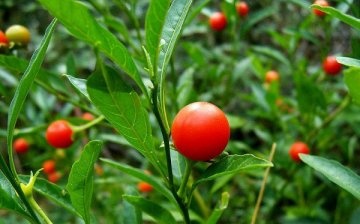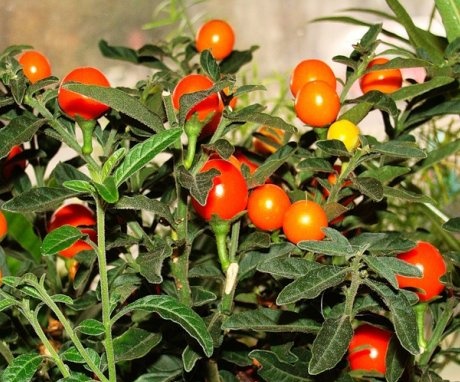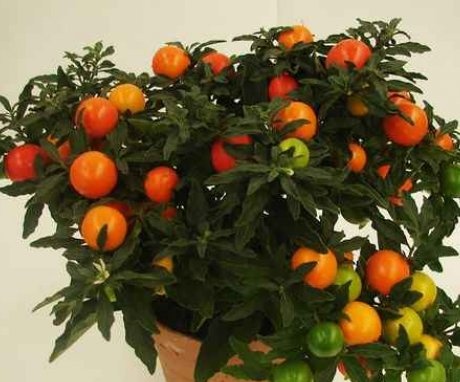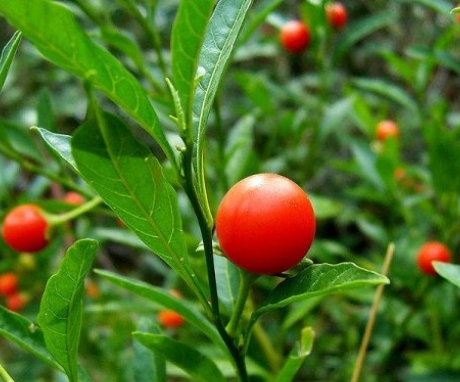Indoor nightshade and its cultivation
If you prefer unusual bright plants at home, be sure to plant indoor nightshade. He will bring a little tropical exoticism to your apartment interior. In nightshade, first of all, berries are attracted, which come in different colors: from bright orange to red.
Content:
Indoor nightshade comes from an amazing tropical country - South Brazil. Therefore, the plant is very fond of moisture, humid climate and needs abundant sunlight. The nightshade grows in the form of a small bush, in height it can reach up to 60 cm.The plant blooms with medium-sized flowers almost throughout the summer, then medium-sized green fruits are formed in place of wilted flowers, which change their color from yellow-orange to red as the winter period approaches ... During this period, nightshade is especially beautiful.
It is possible to preserve the bright appearance of the plant for a longer period if it is placed on a windowsill with good sunlight in a cool room. Under these conditions, the fruits can be stored until February. But in order to achieve such a result, it is necessary to provide the plant with care and a caring attitude.
Caring for indoor nightshade
Care for indoor nightshade it scares some, but the plant is not as picky as many think. If you follow the necessary requirements, nightshade will grow well and even be able to please with the beauty of the fruit.
What is needed for a plant to bear fruit?
- Temperature conditions. In a room where nightshade grows, it is necessary to maintain a constant temperature; in the spring-summer season, the air temperature should be within + 18-25 degrees, and in winter about + 12-15 degrees. If you do not adhere to the required temperature level, nightshade leaves can turn yellow and fall off.
- Lighting. The plant prefers well-lit places, but make sure that bright sunlight does not fall on it. With a lack of light, nightshade does not bear fruit well and sheds foliage. Afraid of a tropical plant and drafts, in the cold season, put a pot of nightshade away from the balcony or loggias, where doors will often open.
- Watering. For good fruiting, nightshade needs abundant watering, since the plant evaporates a lot of moisture during the period of intensive growth. You can even create additional moisture by spraying the leaves periodically. For watering and moistening the leaves, use only warm, settled water. In winter, limit watering, moisten the soil in the pot only as it dries.
- Top dressing. For abundant fruiting, the plant needs a lot of nutrients. Fertilize nightshade during flowering and fruit formation. For this, use a special composition of mineral fertilizers for flowering plants, which can be purchased at a flower shop. After the nightshade has faded, you can reduce the number of dressings, and in winter, stop altogether. feeding.
In summer, indoor nightshade can be taken out on the terrace or veranda so that the plant "breathes" fresh air.
Transplanting and reproduction of indoor nightshade
Transplant nightshade should be carried out annually, and start replanting in February, until the plant is finally "awakened". To do this, prepare a light substrate with sufficient air permeability and pots, which in volume should be slightly larger than the previous ones.
Prune the plant at the same time as replanting. First, cut all the stems to half the height, and when it starts to shoot side shoots, cut them so that a beautiful bush shape is formed.
Perform the next pruning at the end of June to stimulate the plant to branch better.
You can propagate indoor nightshade by seeds or cuttings. The most convenient and easiest way to reproduce is by seed. As the fruit withers, the seeds themselves fall into the topsoil and after a while germinate there. You can gently dig up young shoots and transplant them into separate pots.
You can collect nightshade seeds yourself. To do this, select medium-sized fruits, be sure to ripe, and extract the seeds from them. Rinse them in a solution of potassium permanganate and dry. Sow seeds in spring in pots with a prepared mixture of leafy, peaty soil and sand. Place crops on a windowsill with good lighting, water occasionally and wait patiently for sprouts.
The first shoots should appear in 12-15 days. Usually grown plants dive twice at intervals of a month.
If you prefer to propagate plants cuttingsthen cut the cuttings during transplanting and root them in the substrate or in water. You can carry out cuttings in the summer.
Maybe not everyone knows that house nightshade is a poisonous plant. If your family has small children or pets, it is better to refuse to grow this plant.
The child will always be tempted to taste the bright berries, which are also sweet! And pets can eat a leaf or two of this poisonous plant. It is good to keep indoor nightshade in the office or in the winter garden.



